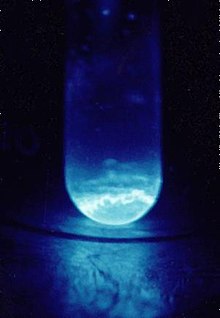The first naturally synthesized element was Technetium (Tc, Z=43), in 1936. This was an important discovery that filled a gap in the periodic table, but since no stable isotopes of technetium exist, it is only found in trace quantities on earth.

Technetium
The first synthetic element that is not found on earth at all, einsteinium (Es, Z=99), was first synthesized in 1952. It was discovered as part of the debris formed by the first hydrogen bomb explosion.

Einsteinium
Other elements that do not occur naturally on earth are all transuranium elements:
Fermium (Fm, Z=100)
Mendelevium (Md, Z=101)
Nobelium (No, Z=102)
Lawrencium (Lr, Z=103)
Rutherfordium (Rf, Z=104)
Dubnium (Db, Z=105)
Seaborgium (Sg, Z=106)
Bohrium (Bh, Z=107)
Hassium (Hs, Z=108)
Meitnerium (Mt, Z=109)
Darmstadtium (Ds, Z=110)
Roentgenium (Rg, Z=111)
Copernicium (Cn, Z=112)
Ununtrium (Uut, Z=113)
Flerovium (Fl, Z=114)
Ununpentium (Uup, Z=115)
Livermorium (Lv, Z=116)
Ununseptium (Uus, Z=117)
Ununoctium (Uuo, Z=118)
One of the coolest elements, Californium (Cf, Z=98) was first discovered synthetically. It was first synthesized in 1950 at UC Berkeley, and is the heaviest element to naturally occur on earth. Californium is unique because it is one of the few transuranium elements that actually have application. Its application comes from its property of emitting neutrons, which can be used in starting nuclear reactors and studying neutron diffraction and neutron spectroscopy. For this reason, in addition to its high price for synthesis, Californium can cost up to 27 million per gram.
Also, one of the ways that elements are synthesized is through a GSI accelerator. Using GSI accelerators, scientists use two existing elements and fuse the nuclei together to create a new element. In the process, atoms can reach speeds of 30,000 kilometers per second. GSI accelerators have been used to discover 6 elements, so far.
Read more:
https://www.gsi.de/en/start/forschung/forschung_bei_gsi_ein_ueberblick/the_creation_of_new_elements.htm